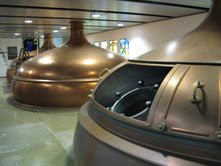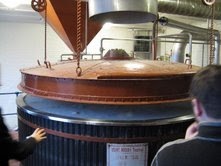
It seems that nothing is off-limits and no ingredient is safe at Allagash brewery in Maine. Allagash is a relative new-comer to Georgia but has been brewing beer for over a decade. Rob Tod, Allagash's owner and brewmaster, launched Allagash with a handful of beers (most notably their White Ale) and plodded along for some time spreading the word about their Belgian-inspired ales with an American flare. Things didn't really get shifted into high gear until they started trickling out their amazing limited release specialty ales that were not only amazing but amazingly hard to get your hands on. That component of the brewery grew to the point that they have been able to expand their line of limited release beers to include unique and delicious newcomers each year.
Fluxus was brewed for the first time in 2007 (the above label is of Fluxus 2007) to commemorate Allagash's 12th anniversary. Fluxus means 'continuous change', which perhaps best describes the personality of one of the nations most innovative breweries. Each year they brew a new batch of Fluxus that is not only a new recipe but a totally different style. This years' Fluxus is a Belgian-style Saison brewed with Sweet Potatoes and black pepper.
The guys at Allagash were generous enough to prepare for us a special cask of this years' Fluxus that exceeded any expectation we might have had for their creation. The creamy carbonation from the cask conditioning was a perfect complement to this wonderfully complex, yet balanced beer. We found the sweet potatoes peeking through towards the end of each sip and the black pepper lending a surprisingly rewarding spice in the finish. This is clearly a beer that the guys at Allagash spent their time on and thought through well in advance. I can't imagine potatoes being easy to brew with or black pepper being easy to balance in a beer yet they have achieved a masterpiece that is well worth seeking out. We tip our hats to the gentlemen from Maine who continue to surprise us with their creativity and their willingness to take a chance on some very unlikely ingredients.













